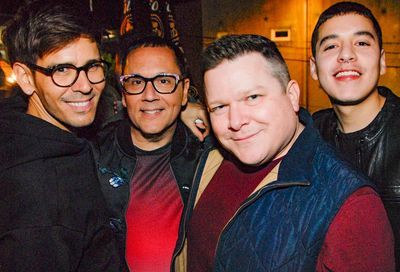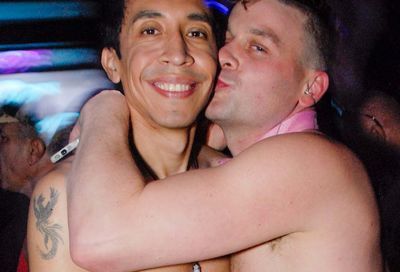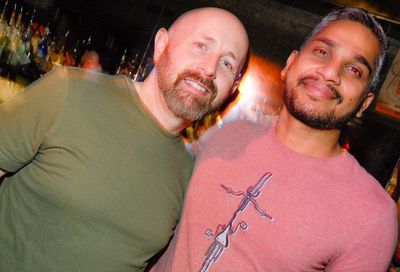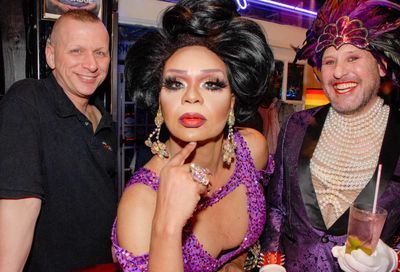Wayne's World: 2007 MAL Weekend
One man's take on the leather community, and his place in it
Wayne M. Nesbitt has a surprisingly common name — at least in the leather community. Yes, that means that people in the community are familiar with his name, but it goes beyond that.
”When I competed at MAL in 1998, there was another Wayne Nesbitt contestant. He was also African American. It was really weird.”
Possibly weirder is that while Nesbitt has been a fixture among metro D.C. leatherfolk for years, he’s never joined any of the clubs associated with the community. That didn’t stop the Centaur MC, however, from naming him an official ”Centaur Groupie.” And the Highwaymen TNT named him and his late partner, Glenn Carpenter, as 1999 ”Honorary Trash of the Year.”

Wayne Nesbitt
Today, at 43, he’s still flying solo. That independent streak was underlined painfully in November, with Carpenter’s death. The couple had been together for 15 years.
”I know that Wayne is a fighter. I’m sure it will be tough for him,” says Larry Barat, Mr. D.C. Eagle 2003 and a member of the Centaurs, the group that organizes the Mid-Atlantic Leather (MAL) Weekend. ”Wayne was very encouraging when I was thinking about competing in 2003. He’s an excellent mentor.”
Like Barat, Nesbitt also carries a title: Mr. DC Eagle 1997-98. He was also the first African American to win that title. And for this weekend’s 2007 MAL contest he’ll serve as a judge. As he readied for that, he talked with Metro Weekly about the upcoming weekend, losing his partner and the future — his own, and the community’s.
METRO WEEKLY: Are you ready for Mid-Atlantic Leather Weekend? Are there special preparations?
WAYNE M. NESBITT: Polish the leather a little bit. I’m mostly ready.
I’m actually working on kind of a neat question for the contestants. It’s a question that’s pretty simple, but part of the question is watching them to see if they follow the directions. I don’t want to reveal any part of the question or the process, but the idea is not just the content of the question but how I ask it and how they handle it.
This is my second time judging. It is a job but it’s fun. I don’t take myself too seriously, but I take the process seriously. It takes up quite a bit of time. Let’s put it this way: If you want to play, you’re not going to have a lot of time to do that. But you can squeeze it in if you’re clever enough.
MW: Will the weekend help you heal from the death of your partner, or would you rather not be dealing with MAL so soon?
NESBITT: It’s a good thing for me to be participating in MAL as a judge. In the simplest way, or on the simplest level, grieving is an ongoing process. When you lose somebody as close as Glenn and I were — I like to tell people we were madly in love with each other because we were — this is a healing process that’s going to take a year maybe. And I think that you have to let the grieving process unfold as it should. You can’t put any timetables or constraints on it. It does whatever it does.
This is a good moment to get out into the community and to receive love and support from friends, and not to be a hermit, because that can happen to you. I’ve been through the grieving process before, losing my dad in 1998 and then my grandmother a year and a half later, so I know what it’s like to lose people who are intensely close to you. But every grieving process is different, so you just have to let it go. But it’s not good to stay isolated too long, at least not for me, anyway.
MW: You and Glenn were both in the leather community for the duration of your 15-year relationship?
NESBITT: We met at what was then called the Frat House, which is now called Omega. It was a completely non-leather situation. We were both sort of at the beginnings of our leather experience. We grew in leather together from the very beginning.
MW: What was the initial attraction — not to Glenn, but to leather?
NESBITT: Oh, boy, that goes way back into teenage years. Thank God for the Village People, by the way, because when I was in high school they were my icons. They were a counterbalance between seeing so many, shall we say, effeminate icons or examples, which I didn’t connect with at all. I thought, ”Isn’t there anything else?” Then the Village People came out with ”Macho Man.” I ran over to someone’s house and they had them plastered on their walls and they were playing the stereo and I thought, ”This is it. This is great.”
It goes back even before that. When I was in kindergarten, they used to send police officers to teach us about safety. They were the most handsome men you have ever seen, in uniforms that were sprayed on. I knew that I was gay immediately, and that really and truly goes back to being in kindergarten at Georgetown Day School.
MW: When did you find out, the Village People excepted, that there were gay men actually living this leather lifestyle?
NESBITT: When I was in high school, I used to play ”Truth or Dare” a lot. I got a dare to get the filthiest straight magazine I could get and bring it to school. So the dare was to get the magazine Jugs. I figured out that somewhere down around 14th Street I could get a copy. I found the magazine, but on another wall I saw this sign that said ”All-male magazines.” There were copies of Colt and another magazine called Strap, and they were all leathermen. I got an instant hard-on when I saw that. That’s when I knew that something else existed. I didn’t know where I was going to find it, but I knew it was out there. I was completely hooked, at least in the back of my mind, to finding out what this leather experience was going to be about and then pursuing it.
It was also the beginning of my first foray into sex, because I noticed at the same time that men would disappear into this darkened doorway [in the bookstore]. Later on, I went back and it didn’t take long to figure out what was going on.
The site where that was at is now the Spy Museum. Somehow, I think that’s terribly appropriate, because I enjoyed the dangerous aspect of it too, you know? The area used to be much seedier then, much more of the thing you would classically think of in the ’70s and early ’80s as an adult-bookstore strip. All that is gone in D.C. now. Back then it was much sleazier.
MW:
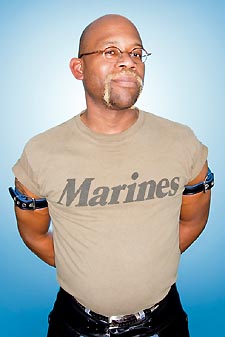 Nesbit |
From those early leather roots till today, you haven’t worn any group’s back-patch. You haven’t joined any leather clubs, have you?
NESBITT: I’m a worker drone. Whenever somebody needs something, I try to be there. Everybody in the community knows me, or knows how to get a hold of me. The fact that I don’t have a back-patch certainly doesn’t stop these folks from asking for a volunteer. And I’m happy to pitch in all the time.
The other good thing about not having a back-patch is it frees you from the politics. Whether you’re talking about the 4-H Club or a leather club, there’s always some level of drama that happens when human beings interact, where there’s responsibilities and power involved. By not having a back-patch, you can come in and serve the community without being associated with the politics.
MW: So, you’re like Switzerland?
NESBITT: [Laughs.] Right. I’m leather Switzerland. That’s a nice way of putting it.
MW: More than being a ”drone,” you’ve raised a lot of money. Is it fair to say you’ve raised about $50,000?
NESBITT: In the time that I’ve done it, from 1996 to the present, we’ve broken the $50,000 mark. It’s mostly through Eagle Wings, which used to be called Silent Bid for Life. It’s an annual fundraiser at the D.C. Eagle. Title-holders and other folks who want to be involved pick two or three charities. Then we assemble a team of volunteers to go out and raise money and do all the organizing. Then the Eagle generously provides the space for an auction.
I can’t take all the credit for it because it grew out of a fundraiser that was created by Ed Moore. My better half in organizing is Peter Lloyd, who is also a perennial of the leather community. He and I sit down and chat about who’s most in need. We’ve tried to scout around every year and see who are the little organizations who don’t have big voices, who can make use of $1,500 or $3,000 or $5,000. One year we targeted Grandma’s House, for example, because we knew that their refrigerators had basically blown up and they had no money to replace them. We try to focus on leather issues and issues involving the GLBT community, but it isn’t strictly limited to that.
MW: Most titleholders seem to have a particular cause that is dear to them. Do you?
NESBITT: No. I try to focus on a lot of different things. One of my mantras is: If we don’t take of each other, nobody else will. But that encompasses a lot of things. It encompasses lesbians with breast cancer or PetsDC. As we’ve discovered when various administrations have left us behind, we have to be the ones who are there providing the services.
MW: Between your day job and your commitments to the leather community, do you have time for much else?
NESBITT: Right before Glenn passed away, we started remodeling the kitchen. We hired some folks to do it, so my kitchen is a wreck. But the new floor has been put down, and it’s beautiful. There are a lot of domestic things happening in my life right now.
Glenn and I had taken a break from our daily or weekly involvement in the leather community. That hiatus has lasted almost two years, so I’m kind of ready to come back and be a little more visible. I’ve had people say, ”We haven’t seen you out in a long, long time.” Well, you’re going to start seeing me more.
I’d like to start doing some more traveling. I just got back from New Orleans. I was at the Rawhide [2010] and Phoenix leather bars down there for New Year’s. That was a lot of fun. Just seeing the other leather people in the other communities is a lot of fun. Sometimes, as the old saying goes, ”It’s good to be fresh meat in another city.”
MW: When you travel, do you have enough notoriety that people say, ”Look! It’s Mr. D.C. Eagle”?
NESBITT: Yeah, a little bit. That amazes me. It’s been almost a decade since I was Mr. D.C. Eagle, and I still get recognized. That’s a very nice compliment. I really take great pride in that, because it means that the impact I made was lasting.
MW: As the first African-American to hold that title, was it at all a political experience?
NESBITT: Oh, yeah. But the responsibility to break glass-ceilings like that belongs to everyone. Sometimes, African Americans bring unfounded baggage to their notion of what the leather experience is. I’ve had would-be African-American titleholders come up to me and say, ”Well, I don’t want to compete for MAL because it’s a white-only experience.” And I say, ”Do you know who ‘D’ Cannon is? Do you know who Jill Carter is? Do you know who Viola Johnson is?” And I rattle off all of these names of African Americans and Latinos who have been in the leather community forever and ever — Marcus Hernandez, for heaven’s sake. And then they go, ”No, I’ve never heard of any of those people.” And I say, ”Well, then, you have some homework to do because your assumption that there are no African Americans, no Latinos and so on, in the leather community is completely wrong.”
By the same token, if you open a [gay] magazine and look at the advertising, 90 percent of it is these white, male, muscle guys. That can be a very alienating experience, especially for a young African-American man who doesn’t see any images of himself on the pages — or up on the stage. Everybody has a responsibility to bridge this gap. Everybody has to take ownership of that.
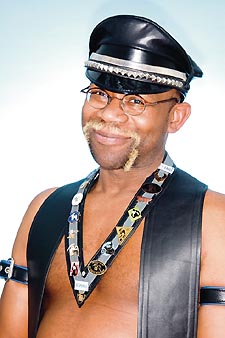 |
MW: Does the leather community do a better job of that than other GLBT communities?
NESBITT: The leather community and the drag community, probably better than any other two communities within the larger umbrella of LGBT, do the best job of making their communities welcoming, open and inviting.
We all know from experience, being gay or LGBT, that discrimination is fired at you at will. When you have experienced discrimination firsthand, it changes your perception of everything else. It makes you, hopefully, more understanding. The leather and drag communities have really picked up on that. Plus, with leather and drag, we always have to fight for everything, because we don’t wear khaki pants and Sperry topsiders. For so long, that has been the ”We don’t want to scare them” mentality: ”Let’s try to look like them. Let’s try to assimilate.” I don’t think that works. I don’t want a seat at the table where I mask myself. I want a seat at the table where I’m there in full leather and chaps. If people don’t like it, well, too bad.
MW: Is Mr. D.C. Eagle the only title you’ve won?
NESBITT: Yeah, that’s it. The first time, in 1996, I didn’t win. I came in second runner-up.
MW: What prompted you to enter?
NESBITT: It was one of those things where you say to yourself, ”Oh, I’ll never do that.” All the while, what you’re really thinking is, ”God, I really want to do that.”
It was thanks to Vern Stewart and Marcus Hernandez, who met me for the first time in 1995. I casually discussed that with them, and they provided the mentorship and the encouragement for me to try for it.
I was disappointed that I didn’t win, but not entirely surprised. I took it as a learning experience. I thought, ”What did I do wrong? What could I have done better?” Then I became fully committed to the idea. I think I volunteered for every leather event in the city. Anytime anybody needed anything done, I was there. That’s how all the leather clubs got to know me, because I basically offered myself as an unconditional ”bottom” to the leather community at that point. [Laughs.] And that was a great experience.
MW: How do you see the leather community evolving? Where do you want it to go?
NESBITT: That’s the $64,000 question, because even in the mid ’90s and into the beginning of the 21st century, there was this thing about the ”old guard” and ”new guard” — about preserving what we might call traditional or classic leather play. A number of folks have already said the traditional leather experience is now a part of history and that leather today has a vastly different agenda.
We’ve moved beyond the most original and traditional modes of play ”top” and ”bottom,” master and slave, where the rules are carefully controlled and carefully defined. Today, leather people play purely for sensation, which means that the experience of play and the mechanisms of play have to be done differently. That’s where we are. Where we’re headed is towards leather that is BDSM play springing from more sensuous origins entirely, and leaving behind very strict rules that define the play.
Although, many people my age or older will tell you that there’s a disadvantage of having leather play not spring from very controlled beginnings. There are a lot of people who want to involve themselves in kinky play who get out there and don’t know what they’re doing. The origins of leather play, as recorded in history, are such that you had to be introduced into the leather family and mentored so that you could be trained, so that you would know how to play safely if you’re going to play with electricity or other things that carry a potential risk. What you see today is folks not knowing how to do it safely. That’s a danger.
Kinky play goes all the way back to the beginning of human existence. There have always been people piercing themselves, doing body modification, tattooing, and then involving themselves in rituals that involve sex and crossing the lines between pleasure and pain.
But leather today, because of the technology, has much more visibility than it did in the past. There is glamour factor — leather harnesses, chaps, pants with codpieces — especially the way it’s photographed. It’s very slick, very polished, very sexy looking. There is that kind of attraction that brings on what I call ”catwalk leather,” where people just want to dress up for a weekend. And there’s nothing wrong with that. But the danger is that people who first dress-up in leather then want to be involved in leather, but don’t really understand all the machinations. Or they’ll try to do it all themselves without really knowing what’s going on. I have a term for that: ”video fisters.”
That used to be a very radical and extreme thing to see in a porno movie, but now it’s just all over the place. Young people think they can watch a couple of videos and then instantly know how to do that. Nothing could be further from the truth. You really need to be taught how to do that: One, first and foremost, so that you do it safely. Guys see these videos where [performers] have spent all this prep time off camera, and then they think they can go into a scene immediately and start fisting some guy. That’s crazy. You can hurt a person like that.
Two, fisting is a really amazing, sensuous experience. When I do that, I go into a trance almost. If you’re not introduced to it properly, you’re going to miss the breadth of the experience. That’s the danger of diluting the experience to the point where people don’t understand or know its origins, and then do things that will put themselves in a situation where they may play unsafely.
I’ll sometimes go up to a person who I know is in his mid 20s, and I’ll say, ”Have you ever heard of the Janus Society? Or have you ever heard of the Mattachine Society?” And they look at me as if I’m from Mars. I’ll tell them that they put themselves out on the line and paid the price so that you can now walk down the street with rainbow chains around your neck; that you have to remember that the level of freedom you have today came at a very, very high price.
MW: Are you confident that the next generation will keep the keep the leather community strong?
NESBITT: I’m worried about it, because if you don’t know those things then you don’t really appreciate the value of the freedom you have. And you don’t work as hard to protect it.
We have much more work to do than the mainstream gay community, because we’re still fighting for just the basic level of understanding. We’re still fighting that battle. If certain people have their druthers, all of this sort of play would just be wiped off the face of the earth. People don’t realize how sinister that really is.
MW: Assuming leather play is not wiped of the face of the earth, is there any chance you’ll compete again?
NESBITT: I’ve been asked that several times over the past few years. My interest in actually competing is drawing to a close, but I’m not going to say that the door is entirely closed yet.
As a titleholder, I would like to pick up the baton of diversity, because I really didn’t do that when I was Mr. D.C. Eagle. I just focused on being a good titleholder and raising money. The truth of the matter is that the leather community already is diverse, and has been for decades, but it needs a better PR image to bring more people in. We need to see more Latinos, more African Americans. They’re already there. They’re just sort of invisible. We just need to make everything a little more visible and tear away that glass barrier, that fence. You can see right through; you just have to finish tearing it down.
Support Metro Weekly’s Journalism
These are challenging times for news organizations. And yet it’s crucial we stay active and provide vital resources and information to both our local readers and the world. So won’t you please take a moment and consider supporting Metro Weekly with a membership? For as little as $5 a month, you can help ensure Metro Weekly magazine and MetroWeekly.com remain free, viable resources as we provide the best, most diverse, culturally-resonant LGBTQ coverage in both the D.C. region and around the world. Memberships come with exclusive perks and discounts, your own personal digital delivery of each week’s magazine (and an archive), access to our Member's Lounge when it launches this fall, and exclusive members-only items like Metro Weekly Membership Mugs and Tote Bags! Check out all our membership levels here and please join us today!
















